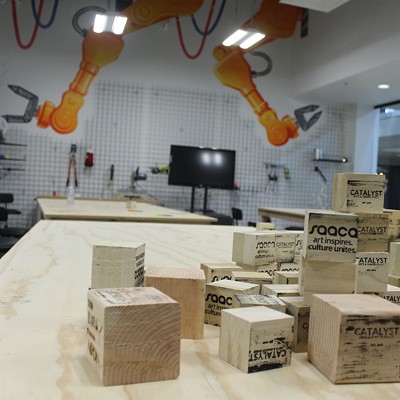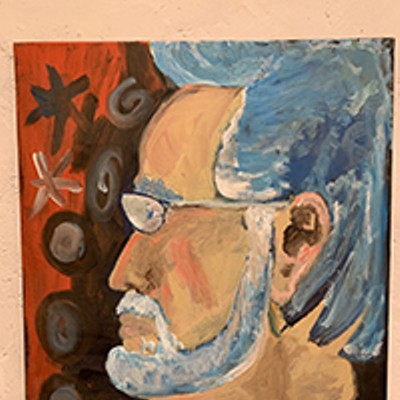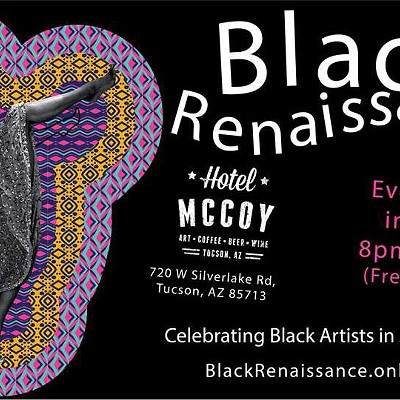"That's a valve cover," these guys say to their friends as Franzone stands by with a Mona Lisa smile.
Franzone has learned that the guys who use his auto-art to demonstrate their knowledge of parts (happens all the time) never buy anything. "If you can name all the parts, you have taken a wrong turn somewhere," he said.
This special knowledge of human behavior about art works made from automobile parts is Franzone's private province--an aspect of psychology revealed exclusively to Franzone.
When you drive up to his residence--the last private place on the road to Aravaipa Canyon wilderness--there's a big sculpture of a dinosaur alongside the road.
Franzone flips a switch to light up the eyes, made from truck running lights, at night for passersby.
Everyone who goes to the Aravaipa Canyon wilderness area for hikes and camping know about the dinosaur. There are piles of certain special car and truck parts and a number of old cars lining both sides of the road.
A large, burly man in his 50s, John Franzone has carved out an unconventional niche in his work and lifestyle. He is completely comfortable about his work, but it's really work. And he knows that nobody else does what he does.
Franzone was born the son of a Sicilian-American machinist in Lindenhurst, N.Y., in 1943.
Franzone joined the Navy in 1960 when he was 17 years old. He was a fire-control technician aboard the USS Canberra heavy cruiser. Franzone fired the Canberra's guns at Cuba in support of the Bay of Pigs invasion.
"The Canberra was offshore providing gunfire support. We didn't know we were in an invasion. I didn't find out until several years later," he said. Franzone received the Navy and Marine Corps Expeditionary Medal.
Later, Franzone served on the destroyer USS Hollister. During the Vietnam War, Franzone participated in "Operation Sea Dragon" whereby the destroyer would go in close to the coast of North Vietnam and pepper coastal positions with 5-inch gunfire. When the North Vietnamese returned fire, the Hollister would radio the gun positions offshore to the battleship USS New Jersey, 20 miles offshore. The New Jersey would let them have it.
"It was anus-clenching adventure," Franzone said.
After 10 years in the Navy, Franzone found himself in Long Beach, Calif., in 1969, working as a mechanic at a gas station.
He ended up owning the gas station--Ray's Mobil. Thus began a long tradition of Franzone's wearing mechanic's shirts with somebody else's name on them. He used Ray's shirts for years. People knew him as Ray. He doesn't mind. He now wears mechanic shirts bearing the name Dave. Now people call him Dave. He doesn't mind.
Franzone learned something about human nature while working as a mechanic and running that gas station in Long Beach. "I was too nice and gave people breaks. People will try to stiff a mechanic. Little old ladies will give you a check and then race to the bank to stop payment," he said.
Since he developed his auto-art, however, he has never been stiffed on money--not once. "A fast mechanic can make more money than a thorough mechanic," he said. "I've never had a hot check for art work, but as a mechanic, I got two or three every week."
"People will pay $700 for my junkyard dog and think nothing of it."
IT WAS AT RAY'S Mobil Station in Long Beach in 1972 that Franzone realized he could make money selling art works made of automobile parts.
A mechanic working for him borrowed $600 to buy a 1952 Plymouth pickup. He gave Franzone his welding equipment as collateral.
"He got a DUI a week later and I got to keep the welding equipment." Franzone taught himself how to weld and made a plant stand out of brake drums and a cam shaft.
"I put it in my office and put a plant in it. A Mobil representative showed up and had to have it. I said $40. He bought it and I said, 'Wow, this could work!'"
These days Franzone loves life on his 10 acres rented from the Quaker Church in Tucson, with a sign FLATS FIXED on the road by the driveway. The 10 acres is a rare and unique property surrounded by the gorgeous wilderness now owned by The Nature Conservancy.
The Nature Conservancy has become Franzone's client. He does their mechanic work as a community service, fixes flats and helps locals with their mechanical problems on a case-by-case basis, never afraid to refuse a job if he has something else to do.
He also has local people who give him cars. "Just tell me where the car is and I will haul it away," he said.
"I haul the cars here, strip them down and use the parts I can; recycle the parts I can't," he says.
Franzone has built a dinosaur out of Model-T parts, calling it a "Model T-Rex." He has sold two of them for $3,600 apiece.
The dinosaur along the road to Aravaipa Canyon has a backbone made from the chain of a trenching machine. "People come here and take pictures of their kids with the dinosaur. Everybody knows the dinosaur."
After 10 years in the antique house tucked up below a rock cliff, he likes his life and admits he's something of a hermit. "I live here purposely," he said.
"I could have a gallery. It's more difficult to be here, but it gives me the solitude to do it. I need time to sit down and gather my thoughts. If I wasn't a hermit I probably couldn't be as creative," he said. "I'm an artist. People want me to make kokopellis all the time. It's like 'The Kokopelli Syndrome.'"
But Franzone won't make kokopellis. He does what he does and that's what he does. He knows what will sell. He knows what he enjoys.
"My market consists of a lot of young people furnishing their first house. They want something different and unique."
Sometimes people come around and expect Franzone to take them through his place and tell them all about his life and work. He finds it tiresome. "I charge them $10. That's not my job. I'm not a tour guide." Franzone walks over to a pile of wheel hubs and drive shafts, rusty and poked through with weeds.
"This is my retirement," he says.
Franzone travels to a few favorite festivals around the country where he has had success selling his unique auto-art. "I'm just trying to be happy. I don't punch anybody else's time clock."
FRANZONE DOESN'T HAVE any imitators because the parts he works with are heavy and what he does is hard work. "It's the perspiration/ inspiration theorem," he says.
He enjoys his solitude, stripping the parts off. "You would be surprised how quick you can take a car apart if you know you never have to put it together again."
In addition to his junkyard dog, he also makes pigs out of Freon tanks, oil filters, ball joints, brake return springs and lugnuts. "It takes all week to make a junkyard dog, but I can make five pigs in three days," he said. "The pigs are $75 and that's really cheap. There are pig people out there and they gotta have it."
As far as custom jobs, Franzone will do them, but he wants some money up front. "If somebody wanted a dinosaur, I can make them one. I take one-third down, the final third on delivery. Give me $1,200 and we can get started."
Franzone says most people don't fully understand what he is doing. "Auto-art is metal sculpture made from automobile parts. It's hard work. It's a labor of love and that's why nobody else is doing it."
"They say 'That's found art--we saw that back in Colorado.' There is a difference. In found art, you find something that looks like a duck, you paint it and call it a duck. In auto-art, when I make a junkyard dog, I start with parts from 12 different cars, none of which looks anything like a dog to start with. So, I am sculpting with automobile parts, much the same as someone else would use clay or stone. Michelangelo was Italian like me."












